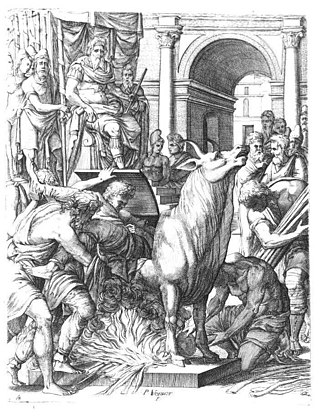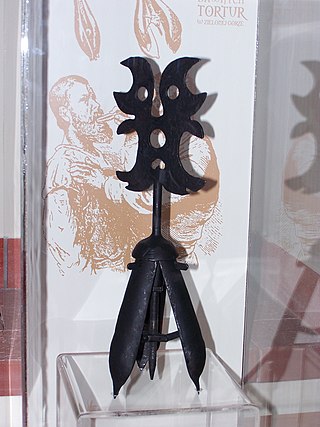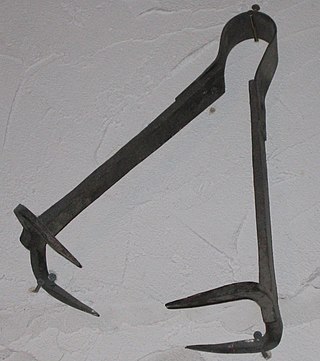This article needs additional citations for verification .(August 2009) |
A list of torture methods and devices includes:
This article needs additional citations for verification .(August 2009) |
A list of torture methods and devices includes:
This section needs additional citations for verification .(June 2018) |
Note that the line between "torture method" and "torture device" is often blurred, particularly when a specifically named implement is but one component of a method. Also, many devices that can be used for torture have mainstream uses, completely unrelated to torture.
There are many variants of the chair, though they all have one thing in common: spikes cover the back, arm-rests, seat, leg-rests, and foot-rests. The number of spikes in one of these chairs ranges from 500 to 1,500.
To avoid movement, the victim's wrists were tied to the chair or, in one version, two bars pushed the arms against arm-rests for the spikes to penetrate the flesh even further. In some versions, there were holes under the chair's bottom where the torturer placed coal to cause severe burns while the victim still remained conscious. In other versions, there were weights that would be placed on the victim's thighs or feet. In a special version, there were spikes on the headrest, and the executioner pushed the victim's head against it.
This instrument's strength lies primarily in the psychological fear caused to the victims. They would often use the victim's fear to coerce them into confessing by forcing the victim to watch someone else be tortured with this instrument.
The time of death greatly varied ranging from a few hours to a day or more. No spikes penetrated any vital organ, and the wounds were closed by the spikes themselves which delayed blood loss greatly.

The rack was first used in antiquity and it is unclear exactly from which civilization it originated, though some of the earliest examples are from Greece.
Arrian's Anabasis of Alexander states that Alexander the Great had the pages who conspired in his assassination, and their mentor, his court historian Callisthenes, tortured on the rack in 328 BC. [3]
The rack is a torture device that consists of an oblong, rectangular, usually wooden frame, slightly raised from the ground, with a roller at one, or both, ends, having at one end a fixed bar to which the legs were fastened, and at the other a movable bar to which the hands were tied. The victim's feet are fastened to one roller, and the wrists are chained to the other.
The torturer turned the handle, causing the ropes to pull the victim's arms. Eventually, the victim's bones were dislocated with a loud crack, caused by snapping cartilage, ligaments or bones. If the torturer kept turning the handles, the limbs would eventually be torn off.
This method was mostly used to extract confessions, not confessing meant that the torturer could stretch more. Sometimes, torturers forced their victim to watch other people be tortured with this device to implant psychological fear.
Many knights from the Knights Templar were tortured with the rack. The limbs collected from this and other punishments of the time were "emptied by the hundreds".
Sometimes, this method was limited to dislocating a few bones, but the torturer often went too far and rendered the legs or arms (sometimes both) useless. In the late Middle Ages, some new variants of this instrument appeared. They often had spikes that penetrated the victim's back - as the limbs were pulled apart, so was his or her spinal cord increasing not only in physical pain but the psychological one of being handicapped at best, too.

The Brazen Bull was invented in Ancient Greece, by Perillos of Athens as a hollow bull-shaped statue in which victims were roasted alive over a fire. Perillos proposed his idea of a more painful means of execution to Phalaris, the tyrant of Akraga. Phalaris liked the idea of the Brazen Bull, and so it was made. Once finished, Phalaris ordered it to be tested on Perillos himself. Perillos was removed from the Bull before he died, but was later killed by Phalaris when he threw Perillos off a hill.[ citation needed ] The Greek had specially engineered tubes to make the screams of the victims sound like the noise of a bull.
The Bull was made wholly of brass, and was hollow with a door in the side.
When a victim was placed inside the brazen bull, they were slowly burned to death. The device gradually became more sophisticated, until the Greeks invented a complex system of tubes in order to make the victim's screams sound more like an infuriated bull, and also made it so the smoke from it rose in clouds of incense. This torture is similar to being boiled alive.
Even though this torture was not used during the Middle Ages as it was used earlier by the Greek and Romans, a simple form of boiling was still used in Central Europe, without the use of the bull.
A pear shaped instrument, consisting of four leaves that slowly separated from each other as the torturer turned the screw at the top.
There is no contemporary first-hand account of those devices or their use. An early mention of a spring-loaded gagging device is in F. de Calvi's L'Inventaire général de l'histoire des larrons ("General inventory of the history of thieves"), written in 1639, which attributes the invention to a robber named Capitaine Gaucherou de Palioly in the days of Henry of Navarre.
Further mentions of the device appear in the 19th century. They are also mentioned in Grose's Dictionary of the Vulgar Tongue (1811) as "Choak Pears," and described as being "formerly used in Holland." [4]
They were also discussed in a book by Eldridge and Watts, superintendent of police and chief inspector of the detective bureau in Boston, Massachusetts (1897). While accepting that ordinary pear-shaped gags exist, they observed that contemporary robbers used no such device as Palioly's Pear and cast doubt upon its very existence in the first place, saying that "fortunately for us this 'diabolical invention' appears to be one of the lost arts, if, indeed, it ever existed outside of de Calvi's head. There is no doubt, however, of the fashioning of a pear-shaped gag which has been largely used in former days by robbers in Europe, and may still be employed to some extent. This is also known as the 'choke-pear', though it is far less marvellous and dangerous than the pear of Palioly."
Though there is little or no evidence of its being used by bandits, there are a number of examples of ornate and elaborate, pear-shaped devices with three or four leaves or lobes, driven by turning a key that rotates the central screw thread, which spreads the leaves. These are generally held in museums devoted to the subject of torture, and are described as instruments of torture by distension or evisceration. Some, but not all, have small spikes of uncertain purpose at the bottom of each leaf. However, these devices do not seem to match the descriptions given by Calvi or the 19th century sources.

This was a form of punishment that was mainly reserved for supposed witches. The victim was tied to a chair which was elevated by ropes above a pond or barrel/vat of water. The victim was then lowered into the water until completely underwater/submerged. The chair was raised if the victim was about to pass out or to give the victim a chance to confess. Often, some form of a plug, or more simply, a piece of fruit, was placed in the victim's mouth and nose beforehand, so they couldn't get a good breath before being dunked. If the victim confessed they would most likely be killed. This method was widely used during the Spanish Inquisition and in England and France. The victim was usually intermittently submerged for many hours until he or she revealed information or death had occurred. Ordeal by water began with the witch-hunts of the 16th and 17th centuries. King James VI of Scotland (later also James I of England) claimed in his Daemonologie that water was so pure an element that it repelled the guilty.
While supposed witches were commonly tortured using this method, thieves and murderers could be subjected to it in order to extract a confession. This was more common when other more sophisticated torture devices were not present.
Dunking was also used as punishment for common scolds.
In England, statute 22 passed in 1532 by Henry VIII, made boiling a legal form of capital punishment. It began to be used for murderers who used poisons after the Bishop of Rochester's cook, Richard Rice, gave a number of people poisoned porridge, resulting in two deaths in February 1532. [5] Boiling to death was employed again in 1542 for a woman who also used poison. [6] [7] It was also used for counterfeiters, swindlers and coin forgers during the Middle Ages. [8]
A large cauldron was filled with water, oil, tar, tallow or molten lead. The liquid was then boiled. Sometimes the victim would be placed in the cauldron before it was boiled so as to be cooked slowly. Or they would be placed, usually head first, into the already boiling liquid.
This was more frequently a way to execute a prisoner rather than to extract a confession.
In the winter, the naked victim was forced to stand outside in full view of everyone. Slowly, the torturer poured water on the victim's head which eventually became frozen, making them die slowly and painfully. Sometimes the body was left for the whole winter to terrify the population and dissuade any further crimes. [ citation needed ]
As its name implies, this method consists of exposing a victim to the elements. The victim could be buried up to their neck letting any animals, insects or other people kill them slowly. [ citation needed ]
The gibbet, a large iron basket with holes large enough for arms and legs, would be hung from a pole with a person inside it. During hot days, the metal would heat, causing pain. During cold days and nights, the chill, as well as lack of protection from the wind, could easily sap a victim's body heat. The holes in the grating were also big enough to allow carrion birds, and the occasional rat, to enter and pluck at a victim's skin and eyes. [ citation needed ]
A cheap and effective way to torture someone was with the use of rats. One of the first documented utilizations of the method was by Diederik Sonoy. [9] There were many variants, but the most common was to force a rat through a victim's body (usually the intestines) as a way to escape. The victim would be completely restrained and tied to the ground or a bed, and the torturer would cut slits into the victim's stomach. The torturer would then use a bowl to trap rats on the victim's stomach, then place hot coal on top of the bowl; the rats would then get hot, and after a few seconds would enter the victim's stomach. Gnawing the intestines usually resulted in a few hours of pain for the victim. This almost always resulted in death.

Torture is the deliberate infliction of severe pain or suffering on a person for various reasons, including punishment, extracting a confession, interrogation for information, or intimidating third parties.

Phalaris was the tyrant of Akragas in Sicily in Magna Graecia, from approximately 570 to 554 BC.
Sensory deprivation or perceptual isolation is the deliberate reduction or removal of stimuli from one or more of the senses. Simple devices such as blindfolds or hoods and earmuffs can cut off sight and hearing, while more complex devices can also cut off the sense of smell, touch, taste, thermoception (heat-sense), and the ability to know which way is down. Sensory deprivation has been used in various alternative medicines and in psychological experiments. When deprived of sensation, the brain attempts to restore sensation in the form of hallucinations.

The iron maiden is a mythical torture device, consisting of a solid iron cabinet with a hinged front and spike-covered interior, sufficiently tall to enclose a human being. The first stories citing the iron maiden were composed in the 19th century. The use of iron maidens is considered to be a myth, heightened by the belief that people of the Middle Ages were uncivilized; evidence of their actual use has never been found. They have become a popular image in media involving the Middle Ages and involving torture chambers.
Cruel and unusual punishment is a phrase in common law describing punishment that is considered unacceptable due to the suffering, pain, or humiliation it inflicts on the person subjected to the sanction. The precise definition varies by jurisdiction, but typically includes punishments that are arbitrary, unnecessary, or overly severe compared to the crime.

The term boot refers to a family of instruments of torture and interrogation variously designed to cause crushing injuries to the foot and/or leg. The boot has taken many forms in various places and times. Common varieties include the Spanish boot and the Malay boot. One type was made of four pieces of narrow wooden board nailed together. The boards were measured to fit the victim's leg. Once the leg was enclosed, wedges would be hammered between the boards, creating pressure. The pressure would be increased until the victim confessed or lost consciousness.

The rack is a torture device consisting of a rectangular, usually wooden frame, slightly raised from the ground, with a roller at one or both ends. The victim's ankles are fastened to one roller and the wrists are chained to the other. As the interrogation progresses, a handle and ratchet mechanism attached to the top roller are used to very gradually retract the chains, slowly increasing the strain on the prisoner's shoulders, hips, knees, and elbows and causing excruciating pain. By means of pulleys and levers, this roller could be rotated on its own axis, thus straining the ropes until the sufferer's joints were dislocated and eventually separated. Additionally, if muscle fibres are stretched excessively, they lose their ability to contract, rendering them ineffective.

Death by boiling is a method of execution in which a person is killed by being immersed in a boiling liquid. While not as common as other methods of execution, boiling to death has been practiced in many parts of Europe and Asia. Due to the lengthy process, death by boiling is an extremely painful method of execution. Executions of this type were often carried out using a large vessel such as a cauldron or a sealed kettle filled with a liquid such as water, oil, tar, or tallow, and a hook and pulley system. Instances of boiling alive as a legal punishment were quite rare and infrequent compared to other forms of execution, such as drowning.
Tickle torture is the prolonged use of tickling to abuse, dominate, harass, humiliate, or interrogate an individual. While laughter is popularly thought of as a pleasure response, in tickle torture, the one being tickled may laugh whether or not they find the experience pleasant. In a tickling situation, laughter can indicate a panic reflex rather than a pleasure response, and the tickling may be a consensual activity or one that is forced, depending on the circumstances. In a consensual form, tickling may be part of a mutually fulfilling, physically intimate act between partners. However, tickle torture can cause real physical and mental distress in a victim, which is why it has been used as an interrogation method or to simply show dominance over another person. Usually tickling is done on feet and armpits after tying the person's ankles and wrists. The recipient is also often stripped to their underwear.
The five techniques, also known as deep interrogation, are a group of interrogation methods developed by the United Kingdom during the 20th century and are currently regarded as a form of torture. Originally developed by British forces in a variety of 20th-century conflicts, they are most notable for being applied to detainees in Northern Ireland during the Troubles. The five collective methods are prolonged wall-standing, hooding, subjection to noise, deprivation of sleep, and deprivation of food and drink.

The pit of despair was a name used by American comparative psychologist Harry Harlow for a device he designed, technically called a vertical chamber apparatus, that he used in experiments on rhesus macaque monkeys at the University of Wisconsin–Madison in the 1970s. The aim of the research was to produce an animal model of depression. Researcher Stephen Suomi described the device as "little more than a stainless-steel trough with sides that sloped to a rounded bottom":
A 3⁄8 in. wire mesh floor 1 in. above the bottom of the chamber allowed waste material to drop through the drain and out of holes drilled in the stainless-steel. The chamber was equipped with a food box and a water-bottle holder, and was covered with a pyramid top [removed in the accompanying photograph], designed to discourage incarcerated subjects from hanging from the upper part of the chamber.

Psychological torture or mental torture is a type of torture that relies primarily on psychological effects, and only secondarily on any physical harm inflicted. Although not all psychological torture involves the use of physical violence, there is a continuum between psychological torture and physical torture. The two are often used in conjunction with one another and often overlap in practice, with the fear and pain induced by physical torture often resulting in long-term psychological effects, and many forms of psychological torture involving some form of pain or coercion.

An iron chair is a torture device that has several different variations depending on its origin and use throughout history. It is also known as the Chinese torture chair or the torture chair. In all cases, the victim was seated on several strips or plates of brass and placed over an open flame and slowly roasted alive. In other variations, the victim was tied to an iron armchair and then slowly pushed nearer and nearer to a blazing fire." Other versions of the chair had the addition of small sharp spikes which lined the back, seat, armrests and leg rests. The number of spikes ranged from 500 to 1,500.

The Apega of Nabis, also known as the Iron Apega, was described by Polybius as an ancient torture device similar to the iron maiden. It was invented by Nabis, a king who ruled Sparta as a tyrant from 207 to 192 BC.

The brazen bull, also known as the bronze bull, Sicilian bull, or bull of Phalaris, was a torture and execution device designed in ancient Greece. According to Diodorus Siculus, recounting the story in Bibliotheca historica, Perilaus (Περίλαος) of Athens invented and proposed it to Phalaris, the tyrant of Akragas, Sicily, as a new means of execution. The bull was said to have been hollow, and made entirely of bronze, with a door in one side. Allegedly, the condemned were locked inside the device, and a fire was set beneath it, heating the metal to the extent that the person within slowly roasted to death. The bull was equipped with an internal acoustic apparatus that converted the screams of the dying into what sounded like the bellows of a bull. The bull's design was such that steam from the cooking flesh of the condemned exited the bull's nostrils, this effect—along with the bull's "bellows"—created the illusion that the bull came to life during every execution. Pindar, who lived less than a century later, expressly associates this instrument of torture with the name of the tyrant Phalaris. Juvenal, in his eighth Satire, lines 81-2, also refers to Phalaris and his bull.

The pear of anguish, also known as choke pear or mouth pear, is a device of disputed use invented in the early modern period. The mechanism consists of a pear-shaped metal body divided into spoon-like segments that can be spread apart with a spring or by turning a key. Its proposed functionality as a torture device is to be variously inserted into the mouth, rectum, or vagina, and then expanded to gag or mutilate the victim; its historical use as a torture device is controversial.

The breast ripper, known in another form as the Iron Spider or simply the Spider, was supposedly a torture instrument used on women, usually who were accused of an array of negative attributes decided by male inquisitors. The instrument was allegedly designed to rip the breasts from a woman and was made from iron, which was usually heated. It was used in the middle ages, but similar concepts were used in ancient Rome. Christian martyrs Agatha of Sicily and Saint Barbara both had their breasts torn off as torture before being killed.
The iron bit, also referred to as a gag, was used by enslavers and overseers as a form of punishment on slaves in the Southern United States. The bit, sometimes depicted as the scold's bridle, uses similar mechanics to that of the common horse bit. The scolds bridle however, is almost always associated with its use on women in the early 17th century and there are very few accounts of the device as a method of torture against black slaves under that particular name. As opposed to the whip, the iron bit lacks the historic, social, and literary symbolic fame that would make information on the use of the iron bit as accessible. Its use throughout history has warranted some attention though, mostly from literary texts. Even earlier, slave narratives and publications of newspapers and magazines from the 18th century on give evidence of this device being used to torture and punish slaves.

Phalaris is the eleventh studio album by Japanese heavy metal band Dir En Grey, released on June 15, 2022, via Firewall Div./SMEJ.